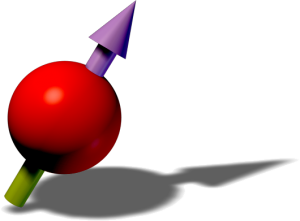Here in Innsbruck, and in Stuttgart and Pisa, clouds of ultracold dipolar atoms have recently been observed in the long-sought after supersolid state, in which there exists global phase coherence and crystalline density structure in the superfluid. Two-component dipolar gases are also now experimentally producible, with our erbium and dysprosium mixtures, however the fate of the supersolid state remains largely unknown.
Together with researchers from Hanover, we predict the existence of a binary supersolid state in which the two components form a series of alternating domains, producing an immiscible double supersolid. Remarkably, we find that a dipolar component can even induce supersolidity in a nondipolar component. In stark contrast to single-component supersolids, the number of crystal sites is not strictly limited by the condensate populations, and the density is hence substantially lower. Our results are applicable to a wide range of dipole moment combinations, marking an important step towards long-lived bulk-supersolidity.
See the pre-print here: arXiv:2203.11119, and the now published paper here: PhysRevA.106.053322
Theory Scientific News
Category for scientific news related to the theory group.
Supersolids go round!
In recent years a new state of matter has appeared on the scene: the supersolid. This has both the crystal structure of a solid and the properties of a superfluid, a quantum fluid that can flow without friction. We show that an established method for forming supersolids in a one-dimensional crystal–by tuning how the particles interact with one another–fails to reach supersolidity in two dimensions. However, by developing a new theoretical technique we demonstrate that cooling a gas of magnetic atoms directly into the supersolid regime is a viable method for creating two-dimensional supersolids in round, pancake-shaped traps. This leads us to the experimental observation of the first supersolid in a round trap, and opens the door to future theoretical studies of the crystal growth.
You can find out more about this in our paper.
New Openings 2022 for PhD and Master-Students!
Maintaining supersolidity from one to two dimensions
Now published in Physical Review A, we theoretically investigate the role of trap geometry plays in determining the dimensionality of dipolar droplet arrays, which range from one-dimensional to zigzag, through to two-dimensional supersolids. Supersolidity is well established in one-dimensional arrays, and may be just as favorable in two-dimensional arrays provided that one appropriately scales the atom number to the trap volume. We develop a tractable variational model—which we benchmark against full numerical simulations—and use it to study droplet crystals and their excitations. We also outline how exotic ring and stripe states may be created with experimentally feasible parameters. Our work paves the way for future studies of two-dimensional dipolar supersolids in realistic settings.
You can see the paper here: E. Poli et al., Phys. Rev. A 104, 063307 (2021) [pdf] [arXiv]
Review article now published in Nature Physics!

Our review on the quantum many-body physics in ultracold magnetic lanthanides is now published in Nature Physics!
Take a look here: Developments in atomic control using ultracold magnetic lanthanides
Two-dimensional supersolidity in a circular trap

Dipolar condensates were recently coaxed into supersolid phases supporting both superfluid and crystal excitations. The first dipolar supersolids consisted of one dimensional droplet arrays, and a recent experiment here achieved two dimensional supersolidity, observing the transition from a linear chain to a zig-zag configuration of droplets.
In this work, in collaboration with Prof. Luis Santos from the Leibniz University Hannover, we show that while one-dimensional supersolids may be prepared from condensates via a roton instability, such a procedure in two dimensions tends to destabilise the supersolid. By evaporatively cooling directly into the supersolid phase–hence bypassing the roton instability–we experimentally produce a 2D supersolid in a near-circular trap, an observation verified through state-of-the-art finite temperature simulations. We show that 2D roton modes have little in common with the supersolid configuration, instead, unstable rotons produce a small number of central droplets, which triggers a nonlinear process of crystal growth. We calculate excitations for a 2D supersolid ground state, and make comparisons with 1D arrays using the static structure factor. These results provide insight into the process of supersolid formation in 2D, and define a realistic path to the formation of large two-dimensional supersolid arrays.
This work has been published in Physical Review Letters, and it can also be found on the arXiv.




